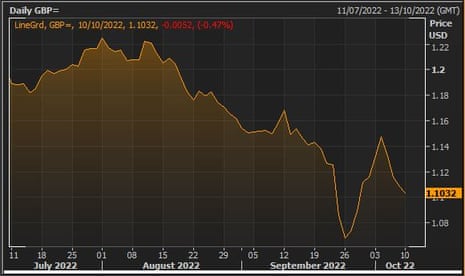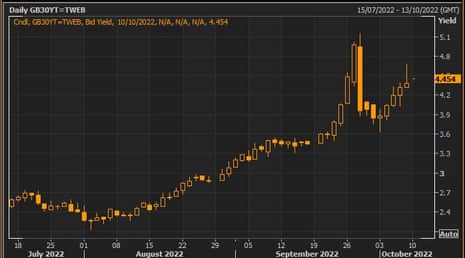[ad_1]
UK to publish fiscal plan and OBR forecasts on 31 October
Just in: Kwasi Kwarteng has brought forward the date of his medium-term fiscal plan, in which he will lay out the government’s debt-cutting plans, to 31 October.
The chancellor announced the change in a letter to parliament’s Treasury Select committee.
The Office for Budget Responsibility’s independent economic forecasts will also be published that day.
The medium-term plan had been scheduled for 23rd November, but Kwarteng has faced growing pressure to present his plan sooner.
Key events
Filters BETA
Politics Live: Truss set for benefits climbdown, DWP minister hints
Kwarteng’s decision to bring forward the medium-term fiscal plan by over three weeks follows pressure from MPs, as well as the financial market.
Having forced a u-turn on the abolition of the 45p top rate of tax, some Conservative MPs have also been resisting the idea that benefits might only rise in line with earnings, not rising prices.
Earlier this morning, Victoria Prentis, a Department for Work and Pensions minister, gave a strong hint that Truss is backing down and giving into the demands of Tories from all wings of the party who want benefits to be uprated in line with inflation.
That would mean a larger increase for households in need (as wages are not keeping up with inflation).
In an interview with Sky News, Prentis said:
It’s really important that we make sure that we target the government resources at the most vulnerable.
Andrew Sparrow’s Politics Live blog has all the details:
Kwasi Kwarteng told the Treasury Committee in his letter that:
“Upon my arrival in office, I received preliminary analysis from the OBR, but I have since made significant policy announcements including the Growth Plan.
“It is important that a forecast includes a full and final assessment of the impact of policy measures on the economy and public finances and, as such, it would not be appropriate to publish the initial analysis that the OBR provided.
“The new forecast date on 31 October will allow the OBR to capture data releases, such as the recent Quarterly National Accounts and Blue Book revisions.
“It will allow for a full forecast process to take place to a standard that satisfies the legal requirements of the Charter for Budget Responsibility enacted by Parliament and that also provides an in-depth assessment of the economy and public finances.
“And it will provide time for the Medium-Term Fiscal Plan to be finalised. In the meantime, the Prime Minister and I met with the OBR’s Budget Responsibility Committee on Friday 30 September to discuss the economic and fiscal outlook, and we will continue to work closely together throughout the forecast process and beyond.”
Mel Stride: This could keep interest rate rises lower
Mel Stride MP, chair of the Treasury Committee, has welcomed the decision to bring forward the medium-term fiscal plan to 31 October.
Stride points out that the Bank of England is due to set interest rates three days later – if Kwasi Kwarteng calms the markets, then interest rates may not need to rise as quickly.
BREAKING: Having pressed so hard on this I strongly welcome decision by @KwasiKwarteng to bring forward @OBR_UK forecast MTFP to 31st Oct. If this lands well with markets then MPC meeting on 3rd Nov may result in smaller rise in int rates. Critical to millions of mortgage holders pic.twitter.com/sgn7mB4ovf
— Mel Stride (@MelJStride) October 10, 2022
The market turmoil caused by the unfunded tax cuts in the mini-budget (totalling over £40bn) and the lack of accompanying independent forecasts, heaped pressure on the chancellor to act faster to set out how the government would pay for the plan, and what their long-term impact would be.
UK to publish fiscal plan and OBR forecasts on 31 October
Just in: Kwasi Kwarteng has brought forward the date of his medium-term fiscal plan, in which he will lay out the government’s debt-cutting plans, to 31 October.
The chancellor announced the change in a letter to parliament’s Treasury Select committee.
The Office for Budget Responsibility’s independent economic forecasts will also be published that day.
The medium-term plan had been scheduled for 23rd November, but Kwarteng has faced growing pressure to present his plan sooner.
Investor morale in the euro zone has fallen the third month running, to levels that signal a deep recession.
The Sentix index for the eurozone confidence has tumbled to -38.3 points this month, from -31.8 in September, the weakest since May 2020, early in the pandemic.
Sentix’s expectations index dropped to -41.0 from -37.0, hitting its lowest value since December 2008, during the financial crisis.
Sentix Managing Director Manfred Huebner said:
At the beginning of October, the sentix economic indices signal an unchanged difficult economic situation – in Europe, but also globally. At -38.3 points, the overall Eurozone index sinks to its lowest level since May 2020.
The ongoing uncertainties about the gas and energy situation in winter have not diminished due to the attack on the Nordstream pipelines. In addition to the economic worries, there is now also an increasing probability of an esca-lation of the military conflict in Ukraine. Globally, there is little reason for hope. Only China seems to be stabilis-ing somewhat at present.
With the dollar strengthening, the pound has dropped to its lowest level since the end of September.
Sterling is down 0.5% at $1.103, below its levels before the mini-budget (but still above the record low of $1.035 set two weeks ago).

The Russian rouble has hit a three-month low as fears grow that Moscow could escalate the Ukraine war, following the attack on Kyiv this morning.
The rouble has dropped to 63 roubles to the US dollar for the first time since early July, before a small recovery.
Russian stocks have also dropped, as geopolitical tensions rise, exacerbated by energy giant Gazprom’s shares starting to trade ex-dividend. The dollar-denominated RTS index has tumbled 6%, while the rouble-based MOEX is down 4%.
The UK government bond selloff is gathering pace, with the 30-year gilt now over 4.5% – up 16 basis points (0.16 percentage points) today.
Despite the Bank’s announcement, long-dated UK bond prices have opened a little lower.
The yield on 30-year UK government bonds have inched up to 4.45%, from 4.38% on Friday night.
Yields rise when prices fall. Before the mini-budget, the 30-year gilt yield was around 3.8%, but it surged over 5% in the days after Kwasi Kwarteng’s statement, forcing the Bank to act.

The Bank of England is providing liquidity support because financial stress in the UK markets remains ‘quite elevated’, explains Professor Costas Milas, of the Management School of the University of Liverpool.
The UK index of financial stress (which takes into account the rise in UK interest rate spreads as well as their volatility) remains as high as when the BoE started its intervention in late September.
Equally important, and as I explain for The Conversation, persistently high financial stress can have a depressing impact on UK GDP for as many as 20 months. So we are not out of the woods yet…
London stock indices open lower
Stocks have opened lower in the City, as worries over the global economy and the Ukraine war weigh on markets.
The blue-chip FTSE 100 index has dropped by 32 points to 6958, down 0.45%.
The domestically-focused FTSE 250 index of smaller companies has lost 0.8%.
Markets are in risk-off mood, after Kiev was targeted by at least four missiles this morning, after a key Russian built bridge in the Crimea was hit by a huge explosion.
The pan-European Stoxx 600 has dropped 0.4%
Last Friday’s US jobs report, showing a continued rise in employment, has deflated investors’ hopes that the Federal Reserve would slow its interest rate rises soon.
And data over the weekend has shown that China’s services activity in September contracted for the first time in four months, as COVID-19 restrictions hit demand and business confidence.
#EnDirecto | Apertura bolsas europeas:
🇩🇪 DAX🔻-0,81%
🇪🇺 EuroStoxx 🔻 -0,83%
🇬🇧 FTSE 🔻 -0,51%
🇫🇷 CAC 🔻 -0,80%
🇮🇹 FTSE MIB 🔻 -0,64%https://t.co/S6BlqkhebB
— Radio Intereconomía (@rintereconomia) October 10, 2022
Updated: Izabella Kaminska of The Blind Spot explains the Bank of England is trying to prevent a ‘fire sale’ of assets, by providing a new facility to help banks provide liquidity to pension funds.
The new facility could also address any shortages of collateral (assets that can be swapped for ready cash).
Ok hearing not so much collateral shortage as a desire to forestall firesales.
— Izabella Kaminska (@izakaminska) October 10, 2022
Interesting that they felt the need to raise the size given how little offers they received in previous operations and how little they have bought
Reserve pricing process remains in place. Either they’re aware of more selling intententions, or they’re wary of the bond sell off
— Antoine Bouvet (@AntoineBouvet2) October 10, 2022
Why the Bank is supporting LDI pensions funds
The Bank launched its support for the pensions industry almost two weeks ago, as pensionsfunds invested in liability driven investment (LDI) were dragged close to a ‘doom loop’.
My colleague Richard Partington explains.
The funds had invested in complex derivatives, using long-dated government bonds as collateral – assets pledged as security to back up a financial contract.
In the market turmoil after the mini-budget, the value of UK government bonds fell sharply as investors began to lose faith in the credibility of the Truss administration to run a sustainable tax and spending policy. This meant a rise in yields – which move inversely to bond prices – in a reflection of the increased cost of government borrowing.
As a result pensions funds invested in LDI schemes faced rolling “margin calls” as the value of the bonds they had pledged as collateral collapsed. The funds then moved to sell other long-dated bonds they held to cover the cash demands, which in turn led to further selling pressure in the bond market in a self-reinforcing downward spiral.
The Bank says that its support will help LDI funds to…
“…address risks to their resilience from volatility in the long-dated gilt market. LDI funds have made substantial progress in doing so over the past week.
Resolution Foundation’s Torsten Bell says the Bank is telling the markets not to test its pledge to restore stability in the long-dated government bond market.
Bank of England sets out its plan to reduce the chance of pension fund driven instability after gilt sales finish on Friday – summary is supporting banks to provide liquidity as @bankofengland itself tries to step back from providing it https://t.co/ooypoxcx40
— Torsten Bell (@TorstenBell) October 10, 2022
Also commits to doubling downs on gilt sales this week if required ie telling markets not to pre-emptively test the @bankofengland
— Torsten Bell (@TorstenBell) October 10, 2022
Former pensions minister Steve Webb says today’s move should reduce the risk of a ‘cliff edge’ when the Bank’s bond-buying programme ends on Friday.
Good to see the Bank of England doubling the limit on its daily limit for gilt purchases (when required). Should help to reduce any risk of a ‘cliff edge’ at the end of the week when the current special measures are switched off.
— Steve Webb (@stevewebb1) October 10, 2022
Some snap reaction:
New: @bankofengland expands gilts intervention. Potential daily debt buying will increase – £10bn today instead of £5bn – & banks & pension funds will be offered collateral support. Aim appears to prop up pensions system without extending debt buying beyond Friday
— Paul Kelso (@pkelso) October 10, 2022
More Bank of England support for unwinding leveraged UK pension fund trades: bigger bond auctions, and a facility to swap collateral including corporate bonds, initially for a month. https://t.co/C8OY5E7WvK
— Peter Thal Larsen (@peter_tl) October 10, 2022
Bank of England expands support for pensions funds through crisis
Good morning, and welcome to our rolling coverage of business, the financial markets and the world economy.
The Bank of England has announcing fresh measures to keep the UK’s financial markets functioning, following the turmoil which hit the pensions industry after last month’s mini-budget.
In a statement this morning, the Bank says it will take three ‘additional measures’ to broaden its support, as it prepares to end its emergency backstop support on Friday.
That emergency support saw the Bank promise to buy up £65bn of long-dated UK bonds – at up to £5bn per day. So far, it has only bought around £5bn, having calmed the market panic that saw bond prices slump.
But with that support ending on Friday, the Bank is pledging to increase the maximum auction size, to up to £10bn per day. That could help maintain financial stability this week, preventing bond prices tumbling and forcing liability driven investment (LDI) pension funds into a dangerous spiral again.
.@bankofengland announces further measures to stabilise markets and ensure pension funds have enough liquidity, when its two-week emergency bond-buying spree ends on Oct 14
— Douglas Fraser✒️🎥🎙 (@BBCDouglasF) October 10, 2022
The Bank says:
To date, the Bank has carried out 8 daily auctions, offering to buy up to £40bn, and has made around £5bn of bond purchases.
The Bank is prepared to deploy this unused capacity to increase the maximum size of the remaining five auctions above the current level of up to £5bn in each auction.
Secondly, the BoE is launching a temporary scheme to help UK banks to ease the liquidity squeeze on liability driven investment (LDI) pension funds, who were forced to sell assets when UK government bond prices slumped.
This Temporary Expanded Collateral Repo Facility (TECRF) will..
“enable banks to help to ease liquidity pressures facing their client LDI funds through liquidity insurance operations”.
TECRF will run beyond the end of this week, providing support once the Bank’s bond-buying scheme ends. It will let the Bank accept a range of assets as collateral – including UK gilts and corporate bonds – to help pension funds facing a liquidity squeeze.
Thirdly, the Bank says it also “stands ready” to help the LDI pension industry through its regular “Indexed Long Term Repo operations”. That will also allow funds to borrow cash from the BoE in exchange for handing over assets as collateral.
Last week, deputy BoE governor Sir Jon Cunliffe explained to MPs that some pension funds came close to collapse amid an “unprecedented” meltdown in UK government bond markets after Kwasi Kwarteng’s mini-budged
This morning’s announcement comes as BoE governor Andrew Bailey prepares to face intense scrutiny in Washington this week, where the annual IMF and World Bank meetings are taking place.
Policymakers and investors worldwide, as well as in the UK, have been wondering whether there will be more market disorder once the the Bank’s bond-buying programme ends on Friday.
There are also concerns that by protecting the pensions industry, the Bank is also supporting the government by lowering borrowing costs.
Also coming up today
Rail passengers in Scotland face widespread travel disruption today as ScotRail workers prepare to take strike action.
Members of the RMT will take part in 24-hour industrial action on Monday over an ongoing pay dispute with the nationalised train operator. It means “a very limited number” of ScotRail services will operate on “a very limited number of routes”.
And the Nobel Memorial Prize in Economic Sciences will be awarded this morning.
The agenda
[ad_2]
Source link




